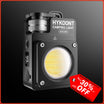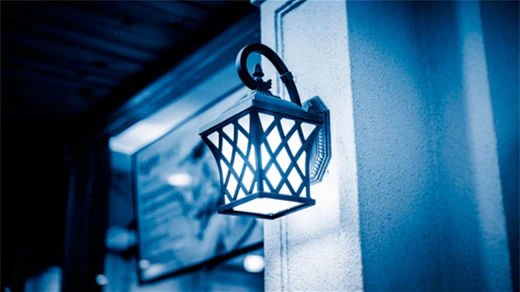Garage door lights play a crucial role in ensuring safety, security, and functionality around the home. By illuminating driveways, walkways, and entry points, these lights help prevent accidents and provide clear visibility during nighttime activities such as parking and unloading. So here’s a comprehensive guide on everything you need to know about garage door lights:
Types of Garage Door Lights
Choosing the right type of light fixture depends on your needs for functionality, security, and aesthetic preferences:
- Wall-Mounted Sconces:
- Placement: Installed on either side of the garage door.
- Function: Provide focused, decorative lighting that enhances the home's exterior. They offer symmetrical lighting which is pleasing to the eye.
- Style: Available in a range of styles from traditional lanterns to modern, sleek designs.
- Overhead Lights:
- Placement: Mounted directly above the garage door.
- Function: Provide broad illumination that covers the entire driveway and entry area.
- Style: Can be subtle, recessed lights, or more prominent fixtures that make a statement.
- Floodlights:
- Placement: Positioned high on the garage or adjacent structures.
- Function: Deliver wide-angle, high-intensity lighting suitable for large areas and security purposes.
- Style: Typically utilitarian in design, focusing on function over form.
- Recessed Lights:
- Placement: Built into the ceiling of the garage or the eaves.
- Function: Offer subtle, unobtrusive garage lighting that can be used for general illumination.
- Style: Minimalist and clean, often used in modern or contemporary designs.
- Motion Sensor Lights:
- Placement: Installed near entry points or areas where movement needs to be detected.
- Function: Automatically turn on when motion is detected, enhancing security and convenience.
- Style: Available in various designs, from simple floodlights to more decorative options.

Key Considerations for Choosing Garage Door Lights
- Brightness:
- Measure in Lumens: Lumens measure the total amount of visible light emitted by a source. For garage door lights, aim for 700-1300 lumens per fixture for adequate illumination.
- Task Lighting: For areas needing more intense light (like for security), higher lumens (1000+ lumens) are recommended.
- Type of Bulb:
- LED (Light Emitting Diode): Energy-efficient, long-lasting (up to 25,000 hours), and available in various color temperatures.
- Halogen: Produces a bright, warm light but is less energy-efficient and generates more heat.
- Fluorescent: Energy-efficient but can be less durable in extremely cold temperatures.
- Solar-powered: Environmentally friendly, relies on sunlight, may not be as bright or reliable in shady or cloudy conditions.
- Material:
- Stainless Steel: Highly resistant to rust and corrosion, very durable, and has a sleek, modern appearance.
- Aluminum: Lightweight, often powder-coated to increase durability and resistance to the elements.
- Brass: Very durable and corrosion-resistant, develops a patina over time adding to its character.
- Bronze: Extremely durable and resistant to corrosion, offers a classic, elegant look.
- High-quality Plastic: Lightweight and rust-proof, but less durable than metal options.
- Weather Resistance:
- IP Rating (Ingress Protection): Indicates the level of protection against dust and water. For outdoor use, look for an IP rating of at least IP65 (dust-tight and protected against water jets).
- Material Durability: Ensure the materials can withstand local climate conditions, such as high humidity, salt air (coastal areas), or extreme temperatures.
- Energy Efficiency:
- Energy Star Rating: Garage lights with this certification meet strict energy efficiency guidelines set by the U.S. Environmental Protection Agency.
- Solar Options: While they reduce electricity costs, ensure they receive adequate sunlight during the day for optimal performance.

- Installation:
- DIY vs. Professional Installation: Some garaege door lights are easy to install yourself, especially if they are solar-powered or plug-in models. Hardwired lights may require professional installation, particularly if new wiring is needed.
- Mounting Options: Ensure the chosen garage door lights can be easily mounted where needed, such as on walls, under eaves, or on poles.
- Smart Features:
- Smart Controls: Some garage door lights can be controlled via smartphone apps, offering features like dimming, scheduling, and remote operation.
- Integration with Smart Home Systems: Ensure the garage lights are compatible with existing systems like Amazon Alexa, Google Home, or Apple HomeKit.
Popular Options and Recommendations
- Wall-mounted Sconces:
- Example: Progress Lighting P560019-031 Gibbes Street Lantern.
- Features: Classic design, durable, weather-resistant materials.
- Overhead Lights:
- Example: Lithonia Lighting OLF 2RH 40K 120 PE BZ M4 LED Flood Light.
- Features: High brightness, energy-efficient, includes motion sensor.
- Floodlights:
- Example: LEONLITE LED Security Lights Motion Sensor Flood Light.
- Features: Wide coverage, adjustable heads, reliable motion detection.
- Recessed Lights:
- Example: TORCHSTAR Basic Series 12-Pack 4 Inch Recessed Light.
- Features: Energy-efficient LEDs, subtle design, ideal for under eaves.
- Motion Sensor Lights:
- Example: RAB Lighting STL360H Super Stealth 360 Sensor.
- Features: 360-degree detection, adjustable sensitivity and range.
Conclusion
Selecting the right garage door lights involves considering factors like brightness, type of bulb, material, weather resistance, energy efficiency, installation complexity, and smart features. By carefully evaluating these aspects, you can choose lights that enhance safety, security, functionality, and the visual appeal of your garage and home exterior.




















![[BOGO] Hykoont LS018 Multi-Function 2 in 1 Flashlight Portable Extendable Adjustable Brightness CCT Bright](http://hykoont.com/cdn/shop/files/STDG18_02986949-cd58-4695-b253-ff6d94f8776a.jpg?v=1762425901&width=104)













Leave a comment
This site is protected by hCaptcha and the hCaptcha Privacy Policy and Terms of Service apply.